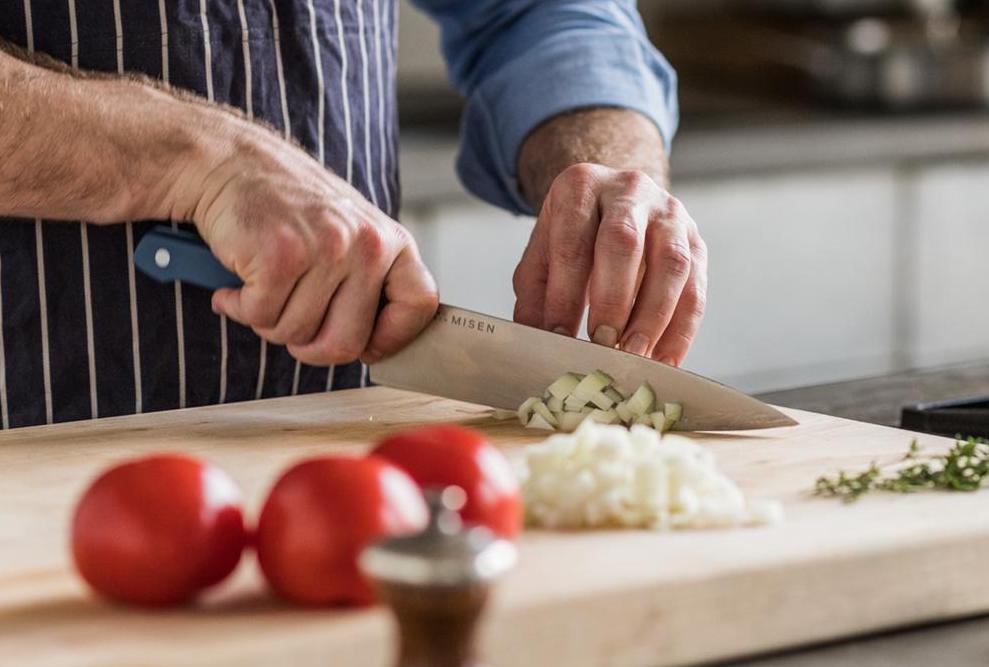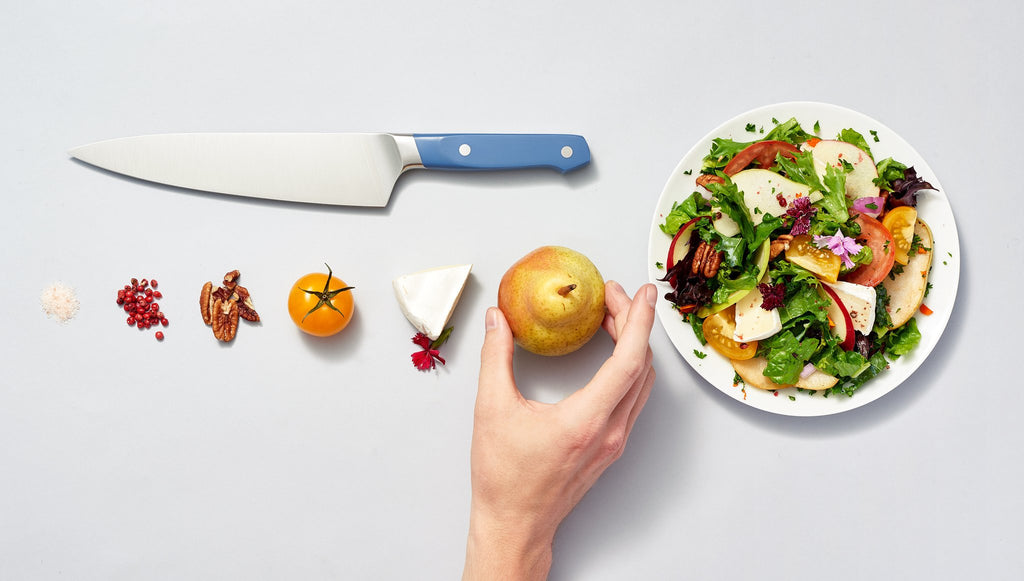Chopped vs. Diced: A Look at 2 Commonly Confused Knife Cuts
 Chopping yields rougher chunks of ingredients, while dicing produces exact, uniform cuts.
Chopping yields rougher chunks of ingredients, while dicing produces exact, uniform cuts.
- Chopping creates chunks that are similar in size, but not necessarily exact in shape, while dicing requires precision and uniform pieces.
- Recipes often call for finely or roughly chopped pieces, which are perfect for smaller or irregular shaped ingredients.
- Dicing can be done in small, medium, or large cubes, depending on how the ingredient will affect the overall cook time and taste.
When making almost any dish, it’s safe to assume that a certain amount of cutting is involved. From easy omelets to slow-cooked pork carnitas, any number of ingredients may need to be prepared before the actual cooking can be done.
But whether the recipe calls for chopped tomatoes or diced onions, the ingredients oftentimes all end up looking the same. This is common. In the rush of meal prep, it’s just easier and faster to give everything the same rough chop. Besides, as long as the ingredients are cut, does the exact way it’s cut really make a difference?
As it turns out, it does. The way you cut your food isn’t just a matter of form, it also affects how the entire dish cooks and comes together. It can take a meal from being half-raw and half-burnt to being done to perfection.
In this article, we'll look at two of the most frequently confused knife cuts: the chop and the dice. While many people regard them as the same thing, there are small yet significant differences. Read below to find out what those are.
Chopped vs. Diced
Say a salad recipe calls for chopped chicken and diced peppers (or diced chicken and chopped peppers). Both of these directives indicate that the ingredient has to be cut down to size. But to what size? And in what shape? Here's a look at the difference between chopping and dicing.
What Is Chopping?
To put it bluntly, to chop is to cut something into pieces. Some recipes may even specify an ingredient be roughly chopped or finely chopped. A rough or coarse chop creates larger chunks of about 3/4 inch, while a fine chop is much smaller at 1/4 inch (although still larger than a mince).
If not stated, chopped ingredients can be anywhere from 1/2- to 3/4-inch pieces. And while they should be similar in size, they don’t have to be uniform. Compared to other knife cuts, chopping yields one of the largest size pieces and is used in many recipes.
What Is Dicing?
Dicing is a much more precise and often smaller cutting technique. With the end goal of cutting an ingredient into cubes of the same size, there are three dice cut sizes — large, medium, and small. A large dice, also called carré, measures about 3/4 inch, a medium dice, or parmentier, is about 1/2 inch, and a small dice, or macédoine, is about 1/4 inch.
Sometimes, a recipe will specify the measurement of the diced ingredients. Sometimes, it won’t. Most of the time, however, it’s safe to go with your gut and dice at whatever size you think works best. For instance, the chicken in a coconut curry will probably be better off with a large dice. But the tomatoes in a pico de gallo can be done in a medium to small dice.
How to Chop
 The easy style of chopping makes it suitable for most home cooking and casual fare.
The easy style of chopping makes it suitable for most home cooking and casual fare.
Most home cooking revolves around chopping. A fine chop for more pungent aromatics, a rough chop for meats or stews, and a standard chop for pretty much everything else.
When chopping, the exact shape of the finished product isn’t as important as it’s size. This freeform style lends itself well to a number of recipes — rustic dishes, comfort food, or anything that will end up blended or puréed. It's also perfect for ingredients that are small (garlic) or oddly-shaped (herbs) and almost impossible to cut uniformly.
The easiest (and funnest!) method of chopping is using the back-and-forth rocking method. To do this, you’ll need a stable cutting board and a well-sharpened chef's knife. The curved cutting edge of a chef’s knife allows it to rock easily over the food for a quick chop.
Start by removing any skin, stem, or other inedible parts, and placing the ingredient in the center of the cutting board. For leafy greens, like basil and parsley, it's a good idea to roll the leaves into a tight bunch.
Then, holding the chef's knife in your dominant hand, position the tip of the blade right above the ingredient. Rest your non-dominant hand on the spine of the blade to keep it steady. Now start rocking the blade down over the ingredient, using several different angles. As you rock, the tip of the blade should never leave the cutting board. If needed, stop to pile the pieces back together and resume chopping.
For larger ingredients and rough chops, it's better to use your non-dominant hand to lightly hold the ingredient in place. Make sure to curl your fingertips in toward your palm in a claw-like fashion to keep your fingers from getting cut.
Instead of rocking, simply slice into the ingredient at intervals of about 1/2 to 3/4 inch. Then take each slice, and slice it again at the same intervals, this time in the opposite direction as the first slice. Repeat until the ingredients are roughly chopped into the same size.
How to Dice
The dice is a knife cut that creates small, uniform pieces. Although it requires a bit more precision and practice, diced ingredients lend themselves well to toppings, sidings, or to part of a larger dish.
For instance, diced tomatoes are a staple in the classic bruschetta, diced fruit is used in chutney, and diced potatoes are perfect in a hearty beef stew.
Taking the extra time and effort to dice ingredients is worth it — it ensures that the dish cooks evenly and the final plating looks much more professional. To begin dicing, have a stable cutting board and a sharp knife. A chef's knife or santoku are good for dense ingredients (think root crops), while a serrated knife is better for soft or thin-skinned produce (like tomatoes).
Most ingredients start with an irregular, organic shape. To get them into equal pieces, it helps to first cut the ingredient into a manageable shape. Take an onion, for example. Start dicing an onion by positioning it on a stable cutting board and using a sharp knife to slice off the stem end.
Next, cut the entire bulb completely in half. Take one half, peel the skin, and lay it with the flat cut side down. With your knife parallel to the cutting board, slice laterally into the onion two or three times at the desired dice size (3/4 inch, 1/2 inch, or 1/4 inch). Slice just until you reach the root end of the onion without cutting the entire length. Leaving the root end for last will help you avoid a messy pile of chopped onion and make the dicing process faster.
Then with the onion half still intact, slice vertically from the top to the bottom, at the same intervals. Rotate the half an onion 90 degrees, and again slice across the vertical cuts you just made until you reach the root end. This should leave you with a nice pile of diced onions and a root you can easily discard. Repeat for the other onion half.
In most other cases, dicing can be done easily by “squaring off” the ingredient. Cut off all round or uneven sides to form a rectangular or straight-edged shape. Then proceed to dice the ingredients to the desired size.
The smaller the dice, the quicker the ingredient cooks. Just take care when throwing them into a hot pan, as small dices also tend to release more liquid and may cause the oil to spatter.
The Importance of Knowing When to Chop or Dice
 The choice between chopping or dicing ingredients can affect the cook time, taste, and texture of a dish.
The choice between chopping or dicing ingredients can affect the cook time, taste, and texture of a dish.
It’s easy to think all these different knife cuts and measurements are just splitting culinary hairs. But most good recipes have been written with cook time, taste, and texture in mind.
Chop instead of dice, and the large chunks may be undercooked. Dice instead of chop and the small pieces may turn to mush.
For example, in a hearty minestrone, carrots and celery both take longer to cook than say, tomatoes and mushrooms. To keep all ingredients the same texture, it’s common for carrots and celery to be diced smaller and placed into the pot earlier. This helps ensure that by the end of cooking, the whole pot of soup has a similarly soft, but not overly mushy, texture.
Even when not cooking, some ingredients will just turn out better either chopped or diced. An already soft ripe avocado, for one, is best chopped into large, biteable chunks. But a pungent raw onion is more palatable in a smaller dice.
Of course, at the end of the day, it’s up to the cook to prepare a dish how they want. So think of how all the ingredients will affect the mouthfeel and taste of the meal, and make the knife cut of your choice.
Cut to Size
A chop and a dice are two very similar types of knife cuts with slight differences in shape and size. But as with most aspects of cooking, even the smallest things can greatly affect how a dish turns out.
Now that you're armed with the above information and a better grasp of what sets both cutting techniques apart, it’s much easier to cook a dish to your precise taste using either a chop or a dice.








